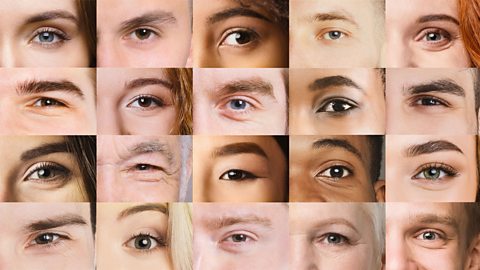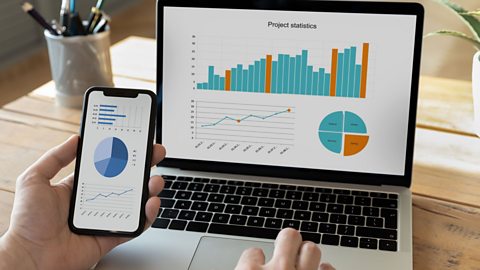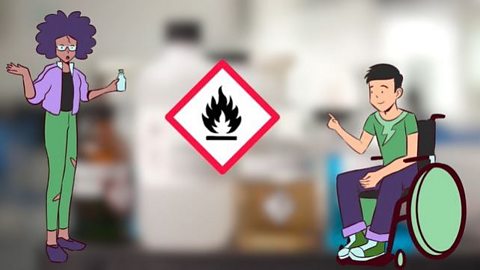Key points
Types of data include continuous, discrete and categoric.
Classifying a variable as a particular type of data is important when considering how to present the data.
Data can be presented in a number of ways, which depends on the type of variable and the uses.
How do scientists collect data to help answer questions?
Scientists collect data from carrying out experiments and investigations.
Video
Watch this video about how to identify continuous and discrete data.
While you are watching, look out for some good examples of continuous and discrete data.
Presenter 2: We are going to look at two different types of data called "discrete" and "continuous" data. It's important to be able to tell the difference between them because this will help us to analyse and understand our results.
Presenter 1: Discrete data is information that can only take certain values and these are often whole number values such as one, two or three woodlice. You don't get one and three-quarter woodlice walking by, so they must be whole numbers.
Presenter 2: Continuous data is information that can take any value, such as speed, so these values don't need to be whole numbers. We are curious about why you find woodlice in dark places.
Student 1: We're going to put all the woodlice into here to see whether or not they prefer the light or the dark, and then we're going to count how many, just to see.
Presenter 2: We will look at the behaviour of woodlice in two different situations - one in a chamber of light and one in the dark.
Presenter 1: After two minutes, we count the number of woodlice in the chamber.
Student 2: OK, 1, 2, 3, 4, 5, 6, 7, 8, 9тІ
Presenter 2: So, is this continuous or discrete data?
Presenter 1: Discrete, because you can only have whole numbers of woodlice. In addition, we have only two choices of light or dark.
Presenter 2: With discrete data, there is a further distinction which needs to be made.
Presenter 1: This is between "categoric" and "numeric".
Presenter 2: Numeric is numbers. For example, numbers of woodlice.
Presenter 1: And categoric is categories, like light or dark, male or female, or three different people, for example Kim, Shuella and Keisha.
Presenter 2: What is the woodlouse with the greatest mass that we can find?
Presenter 1: To answer this question, we need to collect woodlice and weigh them.
Presenter 2: Is this discrete or continuous data?
Presenter 1: Well, the definition of discrete is it has to be whole values.
Presenter 2: But the mass could be any value, so we don't have whole values here.
Presenter 1: So, that makes it continuous data.
Presenter 2: Yes, think about values on a scale. They are continuous, like speed, distance or weight.
Presenter 1: Now we have looked at the difference between continuous and discrete data, but also we have seen the difference between categoric and numeric data, which are two different types of discrete data.
Types of data
In science, investigations involve the collection of data. The data collected can be qualitativeData that is described in words. or quantitativeData that is described in numbers..
Data collected can be:
- continuous variableA variable that has values that can be any number. - numeric data can have any value within a range. Examples include time, height and temperature.
- discrete variableA variable that can only have whole number values. - numeric data that can only have certain values. Examples include shoe size, number of people in a room and the number of marks on a test.
- categoric variableA variable that has values that are words instead of numbers. Examples include gender, hair colour and the name of your school. - the data are words. Examples include colour such as тredт or тblueт, and how an object feels like, eg: тroughт or тsmoothт.
During an experiment, the effect of one variableSomething that can change and be measured. on another is tested. There are three types of variable:
- Independent - a variable that is changed during an experiment.
- Dependent - a variable that is measured or tested during an experiment. This depends on the independent variable.
- Control - a variable, other than the independent variable, that could affect the dependent variable. A control variable is something you keep the same.

The variable that is measured - the dependent variable - is often measured as continuous data, but this is not always the case.
- For example, in an experiment to find out how the temperature of a liquid decreased over time, temperature is the dependent variable and is continuous.
- But in an investigation into eye colour, the number of people is the dependent variable and the data is discrete.


Independent variables can be categoric or continuous.
- An example of categoric data would be тchoice of food for lunchт and 'counting the number of people who chose certain foods'.
- An example of continuous data would be 'temperature': when changing the temperature of water, see how quickly sugar dissolves into it.

True or false?
Dependent variables can be continuous or discrete.
True.
How to present data

The method of presentation depends on:
- The type of variable.
- The reason for presenting the data, eg to sort/ compare/ show a pattern.
Below are ways of presenting data:

| Ways of presenting data | Uses |
|---|---|
| Table | To show data in an order, eg biggest to smallest number. Also used to record results during an experiment. |
| scatter graphA way of presenting data for two variables that are numbers, that helps to show if there is a link between the data. | To find a link between variables. Both variables are quantitative and could be discrete or continuous. A scatter graph is a line graph but without the line joining the points. |
| line graphA way of presenting results when there are two variables that are numbers. | To show how the dependent variable affects the independent variable. Both variables are continuous. The points are joined with a line of best fit, which is straight or a smooth curve. |
| bar chartA way of presenting data where the lengths of the bars (rectangles) represent the values of the variables. | To compare sets of data. The independent variable is usually discrete and the dependent variable is quantitative. |
| pie chartA way of presenting data in which a circle is split into sectors to show the proportions of a total made up of different parts; (often used for percentages.) | To show proportions of a total. The independent variable is discrete or categoric. Often used when showing percentages of data. |
The way in which data is presented depends on the reason for presenting data, and what else?
The type of variable.
Test your knowledge
Quiz - Types of data
Play the Atomic Labs game! gamePlay the Atomic Labs game!
Try out practical experiments in this KS3 science game.

More on Working scientifically
Find out more by working through a topic
- count9 of 11

- count10 of 11

- count11 of 11

- count1 of 11
